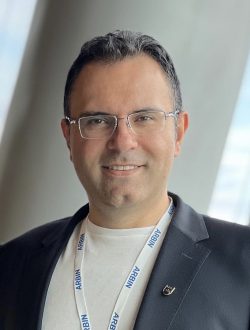Biography
Mohammad Hossein Zarifi (Ph.D. PEng, PRC Tier II, SMIEEE), received the B.Sc., MSc. and Ph.D. degree in electrical and computer engineering from the University of Tabriz, Iran. He is currently an Associate Professor and Tier II Principal’s Research Chair (PRC) in Sensors and Microelectronics at the University of British Columbia, and the director of Okanagan MicroElectronics and Gigahertz Applications laboratory (OMEGA Lab), Canada. He has authored or coauthored more than 100 papers in peer-reviewed journals and conference proceedings as well as 5 issued or pending patents. Dr. Zarifi received CMC-NRC first place award, on industrial collaboration, for the innovative microwave sensors, in Canada, in 2015. Dr Zarifi’s research focuses on applied electromagnetics and smart devices for sensing and communication applications. Dr. Zarifi is a member of IEEE MTT-S TC- 26 “RFID, Wireless Sensor and IoT” and, IEEE MTT-S TC- 4 “Microwave Passive Components and Transmission Line Structures”, and a senior member of the IEEE Solid-State Circuits Society, and the IEEE Microwave Theory and Technology Society, and serves as a reviewer for several journals and conferences. Dr. Zarifi is the recipient of the Emerging Researcher Award and the Best Teaching Award at UBC’s School of Engineering in 2020 and 2021, respectively.
Presentations
Microwave/RF Devices and their Interactions with Novel Nano-Materials for Sensing and Communication Applications
Microwave and Radio Frequency devices have demonstrated significant potential in non-destructive, non-ionizing, contactless, and wireless sensing applications. Among various structures, the ones with planar form factor are more attractive due to their conformal, inexpensive, and straightforward fabrication process. These microwave/RF sensors operate based on the perturbation of the electromagnetic (EM) field and the interaction of the EM field with materials in their close vicinity. Conventionally, these microwave/RF sensors have been fabricated using metal traces and microstrip lines which gives good microwave response and behavior for those sensors monitoring dielectric properties of solid and liquid materials. However, microwave/RF sensor applications were limited in exposure to gas molecules due to their negligible sensitivities to gas molecules. To address this challenge, secondary materials such as polymers, nanomaterials such as carbon nanotubes and titanium nanotubes, and recently titanium carbide (MXene) were introduced to act as an interface layer to enable gas sensing and even light sensing directly at microwave frequencies. This lecture will mainly focus on different planar microwave/RFID-based structures and their interactions with nanomaterials such as TiO2 nanotubes, mesoporous metal-organic frameworks (MOFs), and MXene in exposure to gas molecules and water vapors. Moreover, conductive polymers such as PEDOT:PSS will be discussed in microwave structures as an alternative to metals in microstrip lines to eliminate the use of extra interface materials for monitoring gases. In addition, the potential of 3D printing and other additive manufacturing techniques will be discussed in the nanomaterials concept to empower the microwave/RFID -based sensors.
